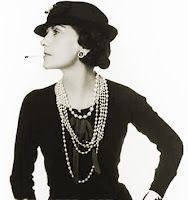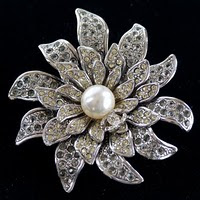Gabrielle was born on August l9, 1883 in Saumur, France. Her mother died when she was twelve, and her father, a traveling wine peddlar, left her and her sister in a convent, where she remained for six years. The poor girls were kept apart from the paying girls and wore a uniform consisting of a black dress with a white collar. It has been said that with her later designs, Chanel was trying to put all the world's women into the uniform she wore in the convent.
She left the convent at 18 and worked in a tailoring shop. But her true passion was to be a music hall performer and she tried singing. Her nickname "Coco" came from a song she sang about a little dog, though she later said it was a pet name used by her father. The small town of Auvernois where Chanel tried to launch her singing career, had a fashionable and aristocratic cavalry regiment. One of the regiment's officers, Etienne Balsan, a sportsman and horse breeder, soon noticed the young "Coco" and she became his mistress and went to live in his chateau at the age of 25.
Balsan's chateau was a hub for hunting friends and their fashionable mistresses. As she started acquiring a foothold in this grand area, the young Coco attracted attention: not only for her ability on a horse but also for her striking beauty.
She began making and wearing attractive hats that were very different from the huge decorated hats worn by the women of the time. Her hats were small and chic, and women admired them and asked for copies. In 1908 Chanel began selling these simply decorated hats from Balsan's ground floor Paris apartment. Arthur Capel was a member of Balsan's circle, and Chanel became infatuated with him. As a businessman, he recognized a potential business-woman in Chanel and set her up in a small shop on the rue Cambon in Paris in 1910. In addition to hats, she started using jersey (up till then used only by French fishermen) to make simple navy jersey dresses.
At this time fashionable women went to the resort towns of Deauville and Biarritz, for the races, and vied to outdo each other with frills, flounces, huge hats, tight corsets, long skirts and everything Chanel detested. Capel believed that Chanel could dress others as well as she could dress herself, and helped her set up shop in 1913. Chanel courted the ladies with her revolutionary style.
Chanel was going to be part of a fashion revolution, not just in the simplicity of her style, but in her choice of materials. Jersey was a flexible silky material which clung to the body, a controversial choice for high fashion. Just as controversial was the length of her hemline, which made a woman's ankles visible.
During the WWI, she moved into a larger shop on rue Cambon, across from the Ritz. She sold flannel blazers, straight linen skirts, sailor tops, long jersey sweaters and skirt-jacket suits. Her suits had above-the-ankle skirts, three-quarter length coats, loosely belted to reveal blouses that matched the jacket lining. She cut her hair into a short bob, wore small hats and a tan, and ensured that she herself was the best advertisement for her style.
She began making and wearing attractive hats that were very different from the huge decorated hats worn by the women of the time. Her hats were small and chic, and women admired them and asked for copies. In 1908 Chanel began selling these simply decorated hats from Balsan's ground floor Paris apartment. Arthur Capel was a member of Balsan's circle, and Chanel became infatuated with him. As a businessman, he recognized a potential business-woman in Chanel and set her up in a small shop on the rue Cambon in Paris in 1910. In addition to hats, she started using jersey (up till then used only by French fishermen) to make simple navy jersey dresses.
At this time fashionable women went to the resort towns of Deauville and Biarritz, for the races, and vied to outdo each other with frills, flounces, huge hats, tight corsets, long skirts and everything Chanel detested. Capel believed that Chanel could dress others as well as she could dress herself, and helped her set up shop in 1913. Chanel courted the ladies with her revolutionary style.
Chanel was going to be part of a fashion revolution, not just in the simplicity of her style, but in her choice of materials. Jersey was a flexible silky material which clung to the body, a controversial choice for high fashion. Just as controversial was the length of her hemline, which made a woman's ankles visible.
During the WWI, she moved into a larger shop on rue Cambon, across from the Ritz. She sold flannel blazers, straight linen skirts, sailor tops, long jersey sweaters and skirt-jacket suits. Her suits had above-the-ankle skirts, three-quarter length coats, loosely belted to reveal blouses that matched the jacket lining. She cut her hair into a short bob, wore small hats and a tan, and ensured that she herself was the best advertisement for her style.
Capel was killed in a car accident on Christmas Eve 1919. Chanel is quoted as saying that this was both the year she became famous and the year she lost everything. In her salon at 31 rue Cambon, she showed increasingly simple day dress-and-coat ensembles, often in beige jersey as well as black evening dresses in lace or jet-embroidered tulle.
During the 1920s, Chanel fully established herself as the Queen of Fashion. She continued to make evening dresses notable for their exquisite simplicity. These dresses differed from their day counterparts only in their fabrics and the degree of intricate construction.
Like most couturiers of the 20s, Chanel designed beaded dresses, but hers were different. Constructed in the round (as opposed to being two flat panels stitched together), they were based on the shapes of her other designs, and the patterns were geometric in color combinations of black, beige and white, or in monochromatic infusions of black or white or red.
Chanel introduced her first costume jewelry in 1924 and she now began to elaborate this vision. Pieces grew in size and became more elaborate, with the use of yellow gold, baroque pearls and rough uncut gems. She wore large clunky button-type earrings and strands of beads interlaced with chains of faceted stones. These became her trade-mark.
 Chanel's most famous design is the suit in two or three pieces. Usually soft and untailored, made in jersey, velvet, silk charmeuse or tweed, these suits share the practical constants of boxy cardigan jackets with sleeve buttons that really button up, pockets where one needs pockets and straight knee-length skirts with walking pleats.
Chanel's most famous design is the suit in two or three pieces. Usually soft and untailored, made in jersey, velvet, silk charmeuse or tweed, these suits share the practical constants of boxy cardigan jackets with sleeve buttons that really button up, pockets where one needs pockets and straight knee-length skirts with walking pleats. Chanel disapproved of suits that could be worn only with the jacket closed so she designed jackets that looked good open, closed or draped over a shoulder. She made blouses which were an integral part of the ensemble, using fabrics matching the suit's lining, printed in corresponding colors or in white with immaculate collar and cuffs.
No less a Chanel trademark is the "little black dress" which she was advocating as the new uniform for afternoon and evening as far back as 1915. Deceptively simple, these dresses were a marvel of cut and proportion. She used traditional elegant materials lace, tulle, embroideries, soft silks in a tailored way.
As her business grew, so did Chanel's social desirability and her personal legend. Her success and her fortune were her entrée, and she manipulated them brilliantly. Chanel from her mansion on the Faubourg St. Honore played hostess to this new world, friends with Picasso, Stravinsky, Cocteau, Hemingway and many others. Colette called her "a little black bull" because she was shrewd and tough but infinitely charming.
Five was Chanel's lucky number. In 1921 Earnest Beaux created a new perfume for her, Chanel used her lucky number. This was the perfume that would make her fortune. Her trademark simplicity was expressed in the shape of the bottle, a design which has never been altered and helps to make it the world's largest selling perfume.
Chanel had not simply found the right perfume, but the perfect way to market it. She was the first designer to do so in her own name. She enabled clients who could not perhaps afford her clothes, to share in her aura. The name on the label was a product as much as the perfume itself. She also brought out No. 22 in the year 1922, Gardenia in 1925 to celebrate Chanel's favorite flower, and Boise de Iles in 1926. In 1927 she brought out Cuir de Russie based on the male fragrance. In 1970, one year before Chanel's death, Henri Robert created No. 19. It's name marks her birthday (August 19) and is known as Chanel's other great number, as it is the house's second best selling perfume. All these perfumes had exactly the same shaped bottle.
With the arrival of the Thirties, Chanel's evening clothes became more elongated, more feminine. Her evening dresses became even more romantic, sometimes strapless, they had full skirts and boned bodices, flounces and ruffles (all the things Chanel had sworn to do away with in 1915).
A competitive situation developed in the thirties between Chanel and Elsa Schiaparelli, whom Chanel referred to as "that Italian artist who makes clothes." Schiaparelli's influence was limited to only one decade, but for this short time, she was the more sensational. This did not force Chanel into trying to do the same thing. Her style was faultlessly elegant, modern and matchlessly chic. The Chanel style of elegance with a foundation of comfort, ease and practicality continued throughout the thirties.
When World War II began, Chanel closed her salon and took up residence at the Ritz Hotel. After the liberation of Paris she left for Switzerland and remained there until 1953.
By 1953 Paris had forgotten Chanel. Dior's "new look" had everyone excited in 1947 and there were many new and successful designers in Paris. Chanel, goaded primarily by the boredom of retirement and a decline in perfume sales, displayed her usual sense of perfect timing. The impact of the "new look" was waning and the stage was set for a return to elegant chic.
At the age of 71 she prepared her new collection in her old salon on the rue Cambon. The French press hated the collection but the Americans loved it and her clothes became a craze a short while afterwards. America sold Chanel, France rejected her, but American buyers saw she was dynamic. Even when she was over 80 she could still pack her salon at rue Cambon. She always said, "fashion fades, only style remains the same."
She died on January 10, 1971 at the age of 88, still designing, still working.
After her death, the house of Chanel was looked after by Yvonne Dudel, Jean Cazaubon and Phlippe Guibourge. The Chanel suit and the Little Black Dress were sold in their usual vast quantities, and all the Chanel products sold very well, but the sparkle had gone. Chanel needed someone to put life back into the veritable house. That someone was Karl Lagerfeld.




Thanks for posting this, Raymond. I really enjoy reading about these vintage designers--Coco Chanel is one of the more well-known designers, but I knew nothing of her history and how she made her trade. So interesting to hear of her progress and how her style progressed over the years==and changed through the time--I mean, from 1908 to 1971--can you imagine if any of today's brand new designers will have that kind of influence over future designers?
ReplyDelete